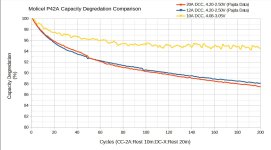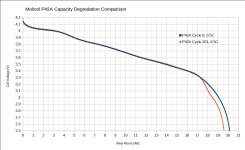TEST:
Referencing Pajda's cycle life tests of High Power density cylindrical cells, the Molicel P42A has a pretty significant non-linear capacity loss in roughly the first 100 cycles before it starts its more linear capacity decay phase. With an extra cell on hand, I was curious how much truncating the high and low SoC from cycling would slow the capacity/cycle decay rate by comparison. 100% capacity is defined as the measured capacity from the first cycle so it's a relative measure, not an absolute measure of capacity degradation.
For cycling, I picked 4.08V and 3.05V arbitrarily. It would be interesting to compare 4.1V to 3.1V or 4.15V to 3.2V as I've read in research papers that the low SoC has a greater impact on capacity loss, but I have no plans to run additional tests at this time.
TEST EQUIPMENT:
- ZKETECH EBC-A20
- BF-2A four-wire cell fixture (10A version with Nickel plated contacts)
- testing room temp ~16-22 °C

DISCUSSION:
The local variance (jagged non-smooth trendline) you see in the chart is basically entirely explained by cyclical temperature variation as the testing room cooled off at night and warmed back up in the morning. Sorry, no temperature controlled test vessel, amateur hour here I know...
Anyway, these results were very interesting to me and show what a dramatic difference limiting the voltage range can have for slowing capacity degradation. At the end of 200 cycles, the relative capacity of Pajda's 3C test was measured at 88.1% vs the Truncated 2.5C test measuring at 94.5% remaining relative capacity. Huge difference.
Another good comparison to reinforce this result is to compare the total Amp-Hours consumed after 200 cycles, which was 588 Ah for the 2.5C test to the 3C test. This consumption matched up to the 3C test's 158th cycle for a total 88.9% relative capacity remaining at this cycle. Not a surprise, but as you can see comparative capacity degradation is not only a function of total capacity consumed.
Finally, I was curious about the impact to absolute capacity before and after the 200 cycle test. I had run a 0.5C D-CC test from 4.2V to 2.5V initially so this worked out well.

0-cycle absolute capacity was measured at 4030 mAh and 201-cycle absolute capacity was measured at 3921 mAh for a loss of only 109 mAh. In other words, the absolute capacity remaining on the 201st cycle was 97.3%! I did not expect this to test this much higher than the relative capacity loss result at 94.5%. If anyone has any thoughts why it came out this way, I'd be interested to read.
In any case, this test was a good validator for me to see the difference practicing good battery management can have on cell/pack lifespan. It's one thing to read the studies and another to check the results personally.
Referencing Pajda's cycle life tests of High Power density cylindrical cells, the Molicel P42A has a pretty significant non-linear capacity loss in roughly the first 100 cycles before it starts its more linear capacity decay phase. With an extra cell on hand, I was curious how much truncating the high and low SoC from cycling would slow the capacity/cycle decay rate by comparison. 100% capacity is defined as the measured capacity from the first cycle so it's a relative measure, not an absolute measure of capacity degradation.
For cycling, I picked 4.08V and 3.05V arbitrarily. It would be interesting to compare 4.1V to 3.1V or 4.15V to 3.2V as I've read in research papers that the low SoC has a greater impact on capacity loss, but I have no plans to run additional tests at this time.
TEST EQUIPMENT:
- ZKETECH EBC-A20
- BF-2A four-wire cell fixture (10A version with Nickel plated contacts)
- testing room temp ~16-22 °C

DISCUSSION:
The local variance (jagged non-smooth trendline) you see in the chart is basically entirely explained by cyclical temperature variation as the testing room cooled off at night and warmed back up in the morning. Sorry, no temperature controlled test vessel, amateur hour here I know...
Anyway, these results were very interesting to me and show what a dramatic difference limiting the voltage range can have for slowing capacity degradation. At the end of 200 cycles, the relative capacity of Pajda's 3C test was measured at 88.1% vs the Truncated 2.5C test measuring at 94.5% remaining relative capacity. Huge difference.
Another good comparison to reinforce this result is to compare the total Amp-Hours consumed after 200 cycles, which was 588 Ah for the 2.5C test to the 3C test. This consumption matched up to the 3C test's 158th cycle for a total 88.9% relative capacity remaining at this cycle. Not a surprise, but as you can see comparative capacity degradation is not only a function of total capacity consumed.
Finally, I was curious about the impact to absolute capacity before and after the 200 cycle test. I had run a 0.5C D-CC test from 4.2V to 2.5V initially so this worked out well.

0-cycle absolute capacity was measured at 4030 mAh and 201-cycle absolute capacity was measured at 3921 mAh for a loss of only 109 mAh. In other words, the absolute capacity remaining on the 201st cycle was 97.3%! I did not expect this to test this much higher than the relative capacity loss result at 94.5%. If anyone has any thoughts why it came out this way, I'd be interested to read.
In any case, this test was a good validator for me to see the difference practicing good battery management can have on cell/pack lifespan. It's one thing to read the studies and another to check the results personally.

